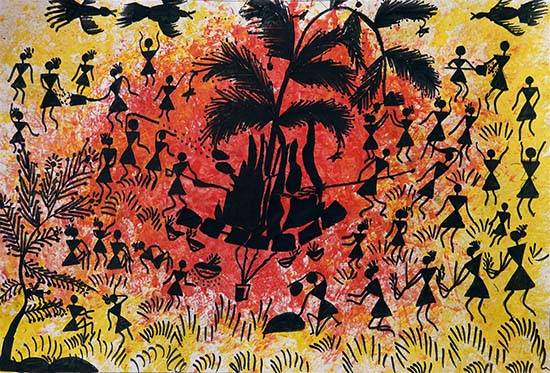Festival of Holi
Holi painting by Asmita Bhoye (class 8), Varwada ashramshala, Tal. Talasari, Dist. Palghar. ( अस्मिता शंकर भोये, इयत्ता आठवी, वरवाडा आश्रमशाळा, जि. पालघर) This is a painting of Holi festival, also known as festival of colours, festival of spring and festival of love.

Listen to Asmita Shankar Bhoye, Class 8, Warvada Ashramshala, Tal. Talasari, Dist. Palghar, Maharashtra. Asmita talks to Milind Sathe of Khula Aasmaan (खुला आसमान) about her painting of "Holi" festival. This painting won a bronze medal in Khula Aasmaan painting competition for children for the period from January to march 2019.
See the art portfolio of Asmita Bhoye
Holi festival - festival of colours, festival of spring, festival of colours
Holi is popularly known as the Indian "festival of spring", the "festival of colours", or the "festival of love". The festival signifies the arrival of spring, the end of winter, the blossoming of love, and for many a festive day to meet others, play and laugh, forget and forgive, and repair broken relationships. The festival also celebrates the beginning of a good spring harvest season. It lasts for a night and a day, starting on the evening of the Purnima (Full Moon day) falling in the Vikram Samvat Calendar, in the Hindu calendar month of Phalgun, which falls around the middle of March in the Gregorian calendar. The first evening is known as Holika Dahan (burning of demon holika) or Chhoti Holi and the following day as Holi, Rangwali Holi, Dhuleti, Dhulandi, or Phagwah.
Celebrations during festival of Holi
Holi celebrations start on the night before Holi with a Holika Dahan where people gather, perform religious rituals in front of the bonfire, and pray that their internal evil be destroyed the way Holika, the sister of the demon king Hiranyakashipu, was killed in the fire. The next morning is celebrated as Rangwali Holi – a free-for-all festival of colours, where people smear each other with colours and drench each other. Water guns and water-filled balloons are also used to play and colour each other. Anyone and everyone is fair game, friend or stranger, rich or poor, man or woman, children, and elders. The frolic and fight with colours occurs in the open streets, open parks, outside temples and buildings. Groups carry drums and other musical instruments, go from place to place, sing and dance. People visit family, friends and foes to throw coloured powders on each other, laugh and gossip, then share Holi delicacies, food and drinks. Some customary drinks include bhang (made from cannabis), which is intoxicating. In the evening, after sobering up, people dress up and visit friends and family. (source : Wikipedia)